What is onboarding?
To begin with, let’s go back to the definition of the term “onboarding”. It is a very well-known Anglicism, as it is used a great deal in the vocabulary of travel, especially when boarding an aircraft; but what does it mean in business?
Onboarding, or integration, represents the period during which your new recruits will immerse themselves in their new work environment and their new role. This is a special time to create a long-term relationship of trust with new employees.
Onboarding has become crucial for companies, which have realised that well-structured and conducted onboarding can increase productivity by up to 70%.
What are the key steps for successful onboarding?
Taking stock
Before you embark on the creation of an onboarding process, it is important to take stock.
Perhaps you do not have a defined process for doing this, but you probably already have existing elements that you can integrate into such a process.
To begin, state the company’s vision, mission, values and culture.
Look at what resources you have at your disposal in terms of tools, training, documentation, etc.
It will also be interesting to interview the various stakeholders to get qualitative feedback on the existing process. This involves HR, managers, teams and also the most recent people to have joined the company, so as to know what works well or not so well. You will then have a clearer vision of the areas where improvements can be made.
This first assessment will allow you to define objectives / axes of improvement and KPIs to measure the impact of the process.
To measure our onboarding process, it will be interesting to look at the following KPIs:
- No-show rate
- Turnover at 2/6/12 months
- Sales performance
- Customer satisfaction (for customer services)
Taking preboarding seriously
Preboarding is the period between the signing of the offer of employment and the new employee’s first working day.
These few weeks or months must be used to build trust.
For this, we can even at this early stage communicate about the company, its values and its mission and give the new employee the feel of the company.
This period can also be a great opportunity to create a link with the manager and the teams by keeping in regular contact. And why not invite the new employee to events?
We can also send some documents concerning structural elements, administration or the schedule of the first week. All this in order to facilitate the entry in post of the new employee.
Engaging with onboarding
The great day has arrived, our new recruit is ready to start!
During these first days, the idea is to guide the new employee through the basics of the company: understanding the organization, functional and human integration, business training.
The human side is essential (especially in case of remote onboarding). This will ensure the proper integration and socialisation of the new employee. Appointing a sponsor or “buddy” can be a good solution.
Onboarding is also the time to learn about the deliverables and the documentation in more depth. We will therefore leave time for familiarisation with the first days’ schedule, the welcome booklet and the welcome kit.
Finally, it is crucial to clarify the usefulness and use of the tools made available for collaborative work, training, administration, etc.
Example of typical onboarding
How can online training portals support the onboarding process?
Online training portal: support at every stage of onboarding
A global support tool, the online training portal helps you at all stages of the onboarding process:
- Preboarding
- Dividing the employee’s development plan into stages
- Identifying strengths/weaknesses
- Discussing the individual training plan
- Taking into account the employee’s personal development aims
- Informing and preparing the employee for taking up his or her duties
- Provision of training / document
- Encouraging him/her to get information by reminders by email / SMS
- Asking the employee to complete his/her profile on the platform
- Dividing the employee’s development plan into stages
- Onboarding
- Integrating the new employee into the company
- Online onboarding portal available
- Allows collection of feedback
- Integrating the new employee into the workplace
- Collecting feedback from employee / manager on the quality of onboarding and points for improvement
- Provision of an online feedback form
- Online onboarding portal available
- Integrating the new employee into the company
Key points to remember for successful onboarding
- Focusing on the employee experience
- Creating a link immediately upon arrival
- Formalising corporate culture and values
- Communication
- Co-building with stakeholders
- Customising from a shared base
- Automating using tools
- Agile approach
- Calling on an expert
We would like to thank Isabelle Vissuzaine, onboarding expert at The Smart Model for her contribution to this article


